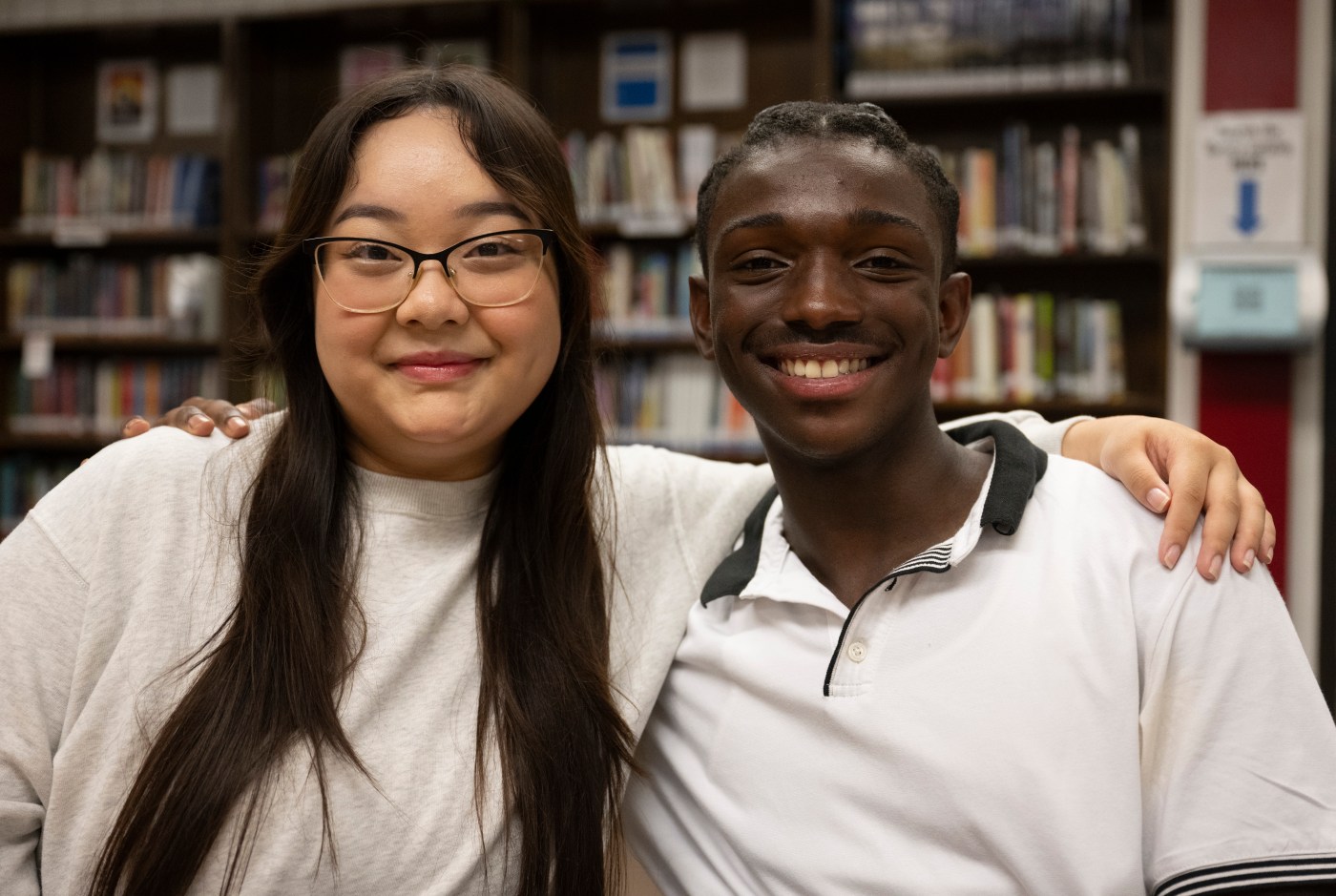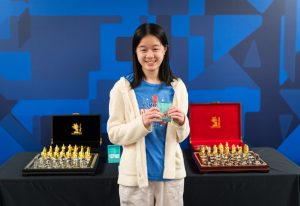
‘Not for school, but for life’: First full class of St. Paul Chinese-immersion program set to graduate
Brouke Brookins couldn’t understand a word his teacher was saying on his first day of kindergarten at Jie Ming Mandarin Immersion Academy.
“We were sitting on the carpet in a circle, all of us, and the teacher walked over and just started speaking another language,” he said. “I remember looking left and right, and I was like, ‘I don’t know what she’s saying. I don’t know if she’s greeting us or what.’”
The same thing happened the next day, and the day after that.
It took several months before Brookins, a member of the first class to complete St. Paul Public Schools’ full K-12 Mandarin-immersion program, finally began to comprehend some words in Mandarin — at school and in his dreams.
“I started dreaming in Chinese, and that’s when I realized, ‘Oh, I know this,’ and the next day at school, all of us were, like, understanding the teacher,” he said. “It started like that. First, we understood what she was saying, but we could not quite speak it yet, and then we transitioned from just understanding what she was saying to us to actually being able to speak it and communicate with each other outside of just talking to the teacher in the class setting.”
Brookins said he and his classmates didn’t know that their teachers also spoke English until they were far along in the program. “They pretended not to know English,” he said. “They just spoke straight Chinese to us.”
Brookins and 19 other seniors in the Chinese-immersion program, housed at Highland Park Senior High School, are now fluent in Mandarin. They graduate June 4.
Brookins, senior class president at Highland Park and captain of the school’s track, Nordic ski and cross-country teams, plans to continue studying Chinese next year in college and study abroad in Taiwan. Brookins will attend Hampton (Va.) University as a pre-med student, but will study Chinese at the College of William & Mary in Williamsburg, Va.
Jie Ming opened in the 2011-12 school year with 17 students at Benjamin E. Mays International Magnet School. School officials added a grade each year and moved the program to Hamline Elementary after two years and to the former Homecroft Elementary School in 2018. It now enrolls more than 400 students.
Jie Ming is one of the district’s highest-achieving, most racially diverse and most popular elementary schools, school district officials say.
It also attracts more students from outside the St. Paul boundaries than other district schools. Jie Ming students continue on in the Chinese-immersion program at Highland Park Middle School and Highland Park High.
Of the 20 graduating seniors this year, more than half have been in the program since Jie Ming, and the rest transferred to Highland in high school or middle school, mostly from Yinghua Academy in Minneapolis.
Choosing immersion
Enrolling Brouke Brookins in Jie Ming was the best decision Tyrone and Dorene Brookins could have made for their son, Tyrone said. “In hindsight, it was absolutely a no-brainer.”
Tyrone Brookins was principal of Benjamin E. Mays when Jie Ming launched; he now serves as assistant superintendent of South Washington County Schools. Dorene Brookins is a social worker in St. Paul Public Schools.
“As educators, we recognized it was a risk because we wouldn’t be able to gauge how he was progressing academically in Mandarin or English,” Tyrone Brookins said. “Brouke was on the gifted and talented track, so the major concern for us was: How will we know if he’s learning and if he’s excelling?
“I remember pulling him into my office, and my wife and I began looking up Mandarin words and phrases on YouTube and Google and asking him if he could understand it — because we wanted to know. It was a rough start, but by December of that kindergarten year, we knew that he was learning it, comprehending it and excelling in it.”
He can attest to the fact that Brouke even dreams in Mandarin, he said.
“There were many nights that we would hear him talking in his sleep and, when we listened closely, we realized it was in Mandarin,” he said. “He continued doing that for years.”
Sophia Paske, 18, of St. Paul, will be using her Chinese-language skills this fall at Duke Kunshan University in Kunshan, a city in southeastern Jiangsu province of China. She leaves Aug. 4.
Paske said her mother, Stacey Starken, always had high expectations when it came to academics. “She wanted me to be able to learn a second language because she studied German and was able to travel in Germany when she was in college, and she had a good experience with that,” she said.
Paske’s parents picked Jie Ming rather than the German-immersion academy, which went only to fifth grade, she said. “They wanted to find a program that would go through high school, so I wouldn’t just forget it after I entered middle school,” she said.
Related Articles
MN Legislature: Classroom cellphone restrictions, a ban on book bans passed this session
Mental health begins in infancy, child development experts tell parents
The number of births continues to fall, despite abortion bans
St. Paul schools could pass $1B budget again despite looming revenue shortfalls
St. Paul student with Down syndrome receives national anti-bullying award
Lovesa Xiong, who also started at Jie Ming in kindergarten, is trilingual. She is fluent in Mandarin, Hmong and English. “My parents emigrated from Laos, and so they were already bilingual with English and Hmong, and they thought that if I learned Chinese, I would have more opportunity by being trilingual,” she said.
Xiong, 18, of Shoreview, will be attending the University of St. Thomas, where she plans to major in international business and minor in Chinese. She eventually would like to work for an American company in China or Taiwan.
Unlike Brookins, Xiong had some familiarity with the Chinese language from “Ni Hao, Kai-Lan,” a TV show on Nickelodeon. “Because I grew up watching that show, little 5-year-old me thought she was fluent in speaking Chinese, so I was like, ‘Oh yeah, I’m so ready for this school. I know how to speak. I can communicate. I got it.’ But then, the first day of class, they spoke Chinese to me, and I was, like, ‘She is not saying the phrases I know how to say. There is no Ni hao. I can’t understand anything.’ So all I did was smile and nod and pretend that I knew what she was saying, but I did not understand anything at all.”
Challenges and successes
Xiong said she remembers the exact day in kindergarten when everything started to “click.”
“My dad picked me up from school, and I wasn’t speaking English to him,” she said. “I was just speaking in Chinese, and I thought he would understand because at school we were just speaking Chinese. There was no English involved. So I was in the car going home. I was just talking about my day, but in Chinese, and he was like, ‘Hey, you’ve got to switch back to English. I don’t understand what’s going on.’ And I was like, ‘Oh, I’m speaking in Chinese.’ That felt like it was my native tongue, and it was just so comfortable to speak in that I didn’t even realize that I was speaking in Chinese.”
But, she said, learning three languages was “really confusing” because some words in Hmong and Chinese “sound really similar, but they have different meanings.”
“So once I learned Hmong, I couldn’t pick up Chinese,” she said. “And then once I picked up Chinese, I couldn’t pick up Hmong, so I was struggling between those languages. And then the part that I struggled with the most was in third grade, when we had to switch to English. We learned (math) in Chinese, and then we had to switch it to English. Oh, and then science was really hard, too, because then not only did we have to learn it in English, we also had to learn it in Chinese. So that was really complicated, and all that knowledge would not fit into my brain.
“I remember coming home from school, and I would be crying. It was so hard. I would cry over my Chinese homework, but my parents couldn’t help me because they didn’t understand how to do it.”
Learning fractions in Chinese was particularly difficult, Brookins said. “When you’re saying fractions, you say it the opposite way,” he said. “We say three-fourths. In (Mandarin), you say four three. Even in geometry, learning the names of shapes, we didn’t learn that it was called a triangular prism. We learned the Chinese name for triangular prism.”
Xiong said that if she has children, she plans to enroll them in a similar language-immersion program in kindergarten.
“I know for sure that my peers who were learning a new language in middle school and high school, it was really difficult for them to start,” she said. “They were not able to pick it right up. I know I cried every day at first, but now it’s easy. I don’t remember the pain anymore because I pick it up just like that.”
Shu-Whei Miao, the Chinese teacher at Highland Park Senior High School, said pronunciation is key when it comes to learning Chinese, a tonal language, and “it is easier to learn the tones well if you start at a young age.”
“Starting young offers the advantage of speaking Chinese tones authentically, similar to a native speaker,” she said.
Learning any foreign language is a great way to expand your horizons, according to Miao. “It not only allows you to understand people with different backgrounds, thoughts and living habits, but it also helps you see that people with diverse cultural, linguistic and living habits have more in common with us than we might think,” she said. “People around the world have more in common with each other than they have differences. Learning Chinese — or any world language — helps reach this goal of better understanding people with different backgrounds.”
Not for school, but for life
Highland Park Senior High School Chinese language teacher Shu-Whei Miao teaches class in St. Paul on Tuesday, May 21, 2024. (John Autey / Pioneer Press)
During a recent class, Miao discussed a phrase that she had written in Chinese on the whiteboard in front of the classroom. “The literal translation is ‘You cannot gain knowledge without practice,’” she said. “But the actual meaning is ‘Wisdom comes from experience.’”
Bobbie Johnson was an English Language Learner teacher with St. Paul Public Schools for many years. She wrote the curriculum for Jie Ming and coordinated the program.
“These students’ families trusted us and put them in our hands to start their Mandarin learning journey,” Johnson said. “It was not easy at the beginning because we used Chinese to teach them from Day 1. They struggled.
“I remember one TV station came to film them, and most of them were not focused. The journalist asked one student what the teacher was teaching. The student yawned and told her she had no clue. After winter break, the students started to understand everything, and they started to fly in their learning. We invited the same journalist back for another story. The journalist was so impressed how fast these students had improved.”
This year’s graduates “truly reflect Jie Ming’s core values: respect, self-control, honesty and diligence,” Johnson said. “They are like my first-born children. I am so proud of every one of them.”
Johnson’s involvement was key to the program’s success, Tyrone Brookins said.
“What started off with a thought became an idea,” he said. “An idea became a program, and that program evolved into a school. And now that school is the flagship school of (SPPS).”
When he spoke at the Jie Ming reunion, Brookins said he told the students that studying Chinese was “Non scholæ sed vitæ,” a Latin phrase which means “Not for school, but for life.”
“I was telling them, ‘Yes, you learned it in school, and you use it for school, but it’s something that you will have for the rest of your life that will provide you with opportunities and will open doors for you,’” he said. “So, the younger students who are at Jie Ming right now, in the beginning and middle of their matriculation as Mandarin-immersion students, they’re doing it for school, but eventually they will realize that it’s something that’s going to benefit them for the rest of their lives.”
Related Articles
St. Paul schools could pass $1B budget again despite looming revenue shortfalls
Markus Flynn: Beyond Brown — the unfinished journey toward educational equity
‘So much to see right in our back yard’: Longtime St. Paul tour guide leads her last trip
St. Paul schools names John Thein as interim superintendent — again
St. Paul high school 4-year graduation rate drops amid slight statewide decline


